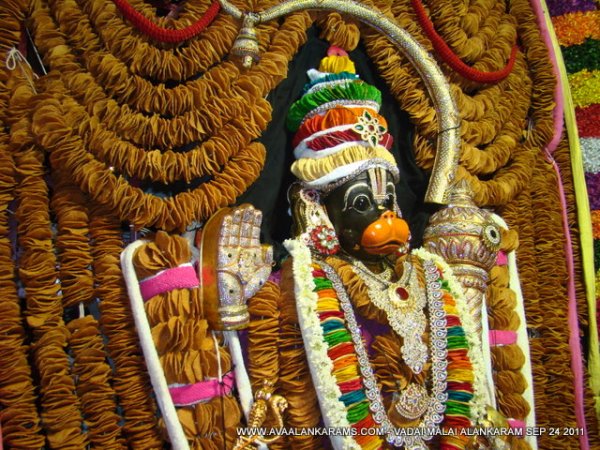S
sunita
Guest
यत्र यत्र रघुनाथ कीर्तनम् तत्र तत्र क्रित मस्तक अन्जलिं बष्पावरी परीपूर्ण लोचनम् मारुतिं नमश्च राक्षस अंतकम्।
That wherever the deeds of Sri Rama are sung,
At all such places does Hanuman cry tears of devotion and joy,
At all such places does his presence remove the fear of demons.

Once a person hailing from North India was among the many who came to have darshan of Paramacharya of Kanchi Mutt. He was seen in hesitancy and Maha Periyava invited him to ask his doubt.
The Northerner cleared his throat and said that Anjeneya Swamy is worshiped all over India but he was not able to understand why in South the people adorn Anjaneya with 'Vada-mala' made of Urad dhal mixed with pepper whereas, in North India they do with sweet Jangiri. He also added that he had not received a convincing answer from anybody.
Paramacharya was pleased to talk about Hanumanji. He began to explain first that children when they make some fuss to eat, the mother coaxes them to see the Moon outside and the child enjoys seeing the bright Moon and the cool breeze outside and finishes eating. Similarly, when Hanuman was a child, he took a liking to look at the Sun blazing in the Sky. He didn't stop with that. He went on to catch the Sun with his hand.
At the same time, 'Rahu Devatha' was also racing to catch the Sun God to eclipse the Sun. In the race between Hanuman and Rahu, Hanuman, being the son of Vayu, the Wind God (Vayuputhra) won with ease. In appreciation of Hanuman's valor, Rahu Deva sanctioned a boon in whoever worshiped Hanumanji with a food item made of urad dhal, will get relieved from 'Rahu Dosha' or that Rahu Graha will not trouble them anymore. Further the item offered to Hanumanji should be in the form of a garland or bent like a serpent which is how 'Rahu God' appears. Rahu also admitted that Urad Dhal is his favorite cereal and food item prepared with Urad Dhal is to his immense liking.
Paramacharya, having explained the significance of Vadamala aaradhana to Anjaneya Swamy went on to bring out the background for the differences in the culture between the people in the South and North. South India is famous for salt cultivation as North is for sugarcane. Vada is a food item made of urad dhal mainly with salt, also some pepper added for improving the taste. So people in South offer vada mala aaradhana to Anjaneya Swamy.
But the Northerners prefer sweet to salt. However, Jangiri is made of mainly urad dhal only which condition satisfies the rule imposed by Rahu God.
Sugarcane grows in plenty in North only. Hence, the people have developed it as a custom to worship Anjaneya Swamy with the garland of Jangiris.
The mass of people who had gathered to listen to Paramacharya, let alone the Northerner, went rapturous and fell at the feet of the Jagathguru.
----
As shared via whatsapp/email
That wherever the deeds of Sri Rama are sung,
At all such places does Hanuman cry tears of devotion and joy,
At all such places does his presence remove the fear of demons.

Once a person hailing from North India was among the many who came to have darshan of Paramacharya of Kanchi Mutt. He was seen in hesitancy and Maha Periyava invited him to ask his doubt.
The Northerner cleared his throat and said that Anjeneya Swamy is worshiped all over India but he was not able to understand why in South the people adorn Anjaneya with 'Vada-mala' made of Urad dhal mixed with pepper whereas, in North India they do with sweet Jangiri. He also added that he had not received a convincing answer from anybody.
Paramacharya was pleased to talk about Hanumanji. He began to explain first that children when they make some fuss to eat, the mother coaxes them to see the Moon outside and the child enjoys seeing the bright Moon and the cool breeze outside and finishes eating. Similarly, when Hanuman was a child, he took a liking to look at the Sun blazing in the Sky. He didn't stop with that. He went on to catch the Sun with his hand.
At the same time, 'Rahu Devatha' was also racing to catch the Sun God to eclipse the Sun. In the race between Hanuman and Rahu, Hanuman, being the son of Vayu, the Wind God (Vayuputhra) won with ease. In appreciation of Hanuman's valor, Rahu Deva sanctioned a boon in whoever worshiped Hanumanji with a food item made of urad dhal, will get relieved from 'Rahu Dosha' or that Rahu Graha will not trouble them anymore. Further the item offered to Hanumanji should be in the form of a garland or bent like a serpent which is how 'Rahu God' appears. Rahu also admitted that Urad Dhal is his favorite cereal and food item prepared with Urad Dhal is to his immense liking.
Paramacharya, having explained the significance of Vadamala aaradhana to Anjaneya Swamy went on to bring out the background for the differences in the culture between the people in the South and North. South India is famous for salt cultivation as North is for sugarcane. Vada is a food item made of urad dhal mainly with salt, also some pepper added for improving the taste. So people in South offer vada mala aaradhana to Anjaneya Swamy.
But the Northerners prefer sweet to salt. However, Jangiri is made of mainly urad dhal only which condition satisfies the rule imposed by Rahu God.
Sugarcane grows in plenty in North only. Hence, the people have developed it as a custom to worship Anjaneya Swamy with the garland of Jangiris.
The mass of people who had gathered to listen to Paramacharya, let alone the Northerner, went rapturous and fell at the feet of the Jagathguru.
----
As shared via whatsapp/email
